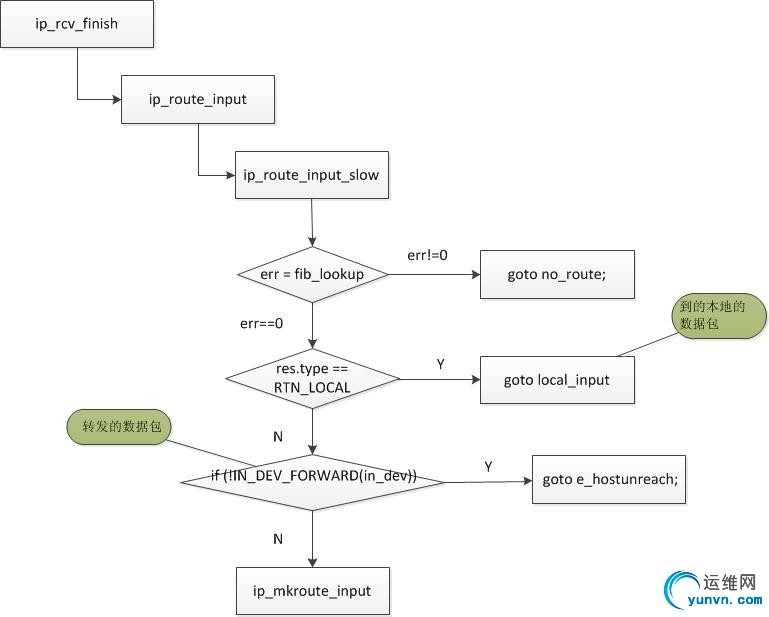|
在进行Linux内核转发时,需要在proc文件系统的proc/sys目录设置转发的参数,可以使用下面的方法查看该参数的值 cat /proc/sys/net/ipv4/ip_forward,该参数的默认值为0,可以使用下面的方法进行修改该值,使能Linux内核的IP层的数据抓发,但是下面的方法在系统重启后不再生效。 echo 1 > /proc/sys/net/ipv4/ip_forward
在Linux系统中也提供了一个系统的配置工具sysctl,使用它可以读取和配置Linux内核的一些参数。但是该方法和proc文件系统相关,使用该工具Linux内核需要支持proc文件系统。下面是使用sysctl配置内核的转发参数。
# sysctl net.ipv4.ip_forward
net.ipv4.ip_forward = 0
/ # sysctl -w net.ipv4.ip_forward=1
net.ipv4.ip_forward = 1
/ # sysctl net.ipv4.ip_forward
net.ipv4.ip_forward = 1
/ #
注意,参数 net.ipv4.ip_forward 实际是对应的 proc 目录/proc/sys/net/ipv4/ip_forward,选项 -w 表示配置该内核配置参数,没有选项表示读内核配置参数,不加任何选项信息,就表示读取操作。 通过上面的方法我们可以设置和读取IP转发的参数。但是本文重点不是讲该参数如何配置,而是在配置完成后,在内核的转发过程中如何生效的,以及如何配置到内核中。既然,该参数是配置使能IP层的转发,那应该在Linux内核的转发部分对该参数进行了判断,该参数的判断实际上是在查找路由时进行判断的,下面这张图显示了其中的调用关系,

在查路由的过程中,如果是转发的数据包调用下面的宏判断转发的参数是否开启。在函数ip_route_input_slow。 if (!IN_DEV_FORWARD(in_dev)) gotoe_hostunreach; 看一下该宏是如何进行定义的,下面的宏定义在include/linux/inetdevice.h文件中。 #defineIN_DEV_FORWARD(in_dev) IN_DEV_CONF_GET((in_dev), FORWARDING) 在把IN_DEV_CONF_GET宏进一步展开了看: #define IN_DEV_CONF_GET(in_dev, attr) \ ipv4_devconf_get((in_dev),NET_IPV4_CONF_ ## attr)//这里的##表示连接两个字符串。 下面是ipv4_devconf_get函数的定义: staticinline int ipv4_devconf_get(struct in_device *in_dev, int index) { index--;//这里的index相当于NET_IPV4_CONF_FORWARDING return in_dev->cnf.data[index];// init_net->ipv4.devconf_dfl.data[0] } (1)对于宏NET_IPV4_CONF_ FORWARDING,定义在include/linux/sysctl.h文件中,是一个枚举类型的。 enum { NET_IPV4_CONF_FORWARDING=1, NET_IPV4_CONF_MC_FORWARDING=2, NET_IPV4_CONF_PROXY_ARP=3, NET_IPV4_CONF_ACCEPT_REDIRECTS=4, NET_IPV4_CONF_SECURE_REDIRECTS=5, NET_IPV4_CONF_SEND_REDIRECTS=6, NET_IPV4_CONF_SHARED_MEDIA=7, NET_IPV4_CONF_RP_FILTER=8, NET_IPV4_CONF_ACCEPT_SOURCE_ROUTE=9, NET_IPV4_CONF_BOOTP_RELAY=10, NET_IPV4_CONF_LOG_MARTIANS=11, NET_IPV4_CONF_TAG=12, NET_IPV4_CONF_ARPFILTER=13, NET_IPV4_CONF_MEDIUM_ID=14, NET_IPV4_CONF_NOXFRM=15, NET_IPV4_CONF_NOPOLICY=16, NET_IPV4_CONF_FORCE_IGMP_VERSION=17, NET_IPV4_CONF_ARP_ANNOUNCE=18, NET_IPV4_CONF_ARP_IGNORE=19, NET_IPV4_CONF_PROMOTE_SECONDARIES=20, NET_IPV4_CONF_ARP_ACCEPT=21, NET_IPV4_CONF_ARP_NOTIFY=22, NET_IPV4_CONF_SRC_VMARK=24, __NET_IPV4_CONF_MAX }; (2)对于returnin_dev->cnf.data[index];返回的相当于in_dev->cnf.data[0],那下面我们看一下该初始值是如何产生的。 首先,in_dev是怎么获取到的,在ip_route_input_slow函数中通过structin_device *in_dev = in_dev_get(dev);函数获取,在in_dev_get函数中调用__in_dev_get_rcu,通过下面的赋值语句进行赋值struct in_device *in_dev = dev->ip_ptr; staticinline struct in_device *__in_dev_get_rcu(const struct net_device *dev) { struct in_device *in_dev =dev->ip_ptr; if (in_dev) in_dev =rcu_dereference(in_dev); return in_dev; }
static__inline__ struct in_device * in_dev_get(conststruct net_device *dev) { struct in_device *in_dev;
rcu_read_lock(); in_dev = __in_dev_get_rcu(dev); if (in_dev) atomic_inc(&in_dev->refcnt); rcu_read_unlock(); return in_dev; } dev->ip_ptr;又是什么时候赋值呢?答案是在net_device注册初始化函数inetdev_init中, static struct in_device*inetdev_init(struct net_device *dev) { structin_device *in_dev;
ASSERT_RTNL();
in_dev= kzalloc(sizeof(*in_dev), GFP_KERNEL); if(!in_dev) gotoout; memcpy(&in_dev->cnf,dev_net(dev)->ipv4.devconf_dflt, sizeof(in_dev->cnf));//这里对in_dev->cnt进行初始化操作,---(1) in_dev->cnf.sysctl= NULL; in_dev->dev= dev; if((in_dev->arp_parms = neigh_parms_alloc(dev, &arp_tbl)) == NULL) gotoout_kfree; if(IPV4_DEVCONF(in_dev->cnf, FORWARDING)) dev_disable_lro(dev); /*Reference in_dev->dev */ dev_hold(dev); /*Account for reference dev->ip_ptr (below) */ in_dev_hold(in_dev);
devinet_sysctl_register(in_dev); ip_mc_init_dev(in_dev); if(dev->flags & IFF_UP) ip_mc_up(in_dev);
/*we can receive as soon as ip_ptr is set -- do this last */ rcu_assign_pointer(dev->ip_ptr,in_dev);//使用RCU保护锁机制对dev->ip_ptr进行赋值 out: returnin_dev; out_kfree: kfree(in_dev); in_dev= NULL; gotoout; } (1)dev_net(dev)->ipv4.devconf_dfl 也就相当于init_net->ipv4.devconf_dfl,而devconf_dfl的初始化时在/net/ipv4/devinet.c文件中,devinet_init_net函数中, static struct ipv4_devconfipv4_devconf_dflt = {
.data = {
[NET_IPV4_CONF_ACCEPT_REDIRECTS- 1] = 1,
[NET_IPV4_CONF_SEND_REDIRECTS- 1] = 1,
[NET_IPV4_CONF_SECURE_REDIRECTS- 1] = 1,
[NET_IPV4_CONF_SHARED_MEDIA- 1] = 1,
[NET_IPV4_CONF_ACCEPT_SOURCE_ROUTE- 1] = 1,
},
};//这里并没有对FORWARDING进行赋值操作
static __net_init intdevinet_init_net(struct net *net)
{
interr;
structipv4_devconf *all, *dflt;
#ifdef CONFIG_SYSCTL
struct ctl_table *tbl = ctl_forward_entry;
structctl_table_header *forw_hdr;
#endif
err= -ENOMEM;
all = &ipv4_devconf; //----------------------------进行初始化操作
dflt = &ipv4_devconf_dflt;
if(net != &init_net) {
all= kmemdup(all, sizeof(ipv4_devconf), GFP_KERNEL);
if(all == NULL)
gotoerr_alloc_all;
dflt= kmemdup(dflt, sizeof(ipv4_devconf_dflt), GFP_KERNEL);
if(dflt == NULL)
gotoerr_alloc_dflt;
#ifdef CONFIG_SYSCTL
tbl= kmemdup(tbl, sizeof(ctl_forward_entry), GFP_KERNEL);
if(tbl == NULL)
gotoerr_alloc_ctl;
tbl[0].data= &all->data[NET_IPV4_CONF_FORWARDING - 1];
tbl[0].extra1= all;
tbl[0].extra2= net;
#endif
}
#ifdef CONFIG_SYSCTL
err= __devinet_sysctl_register(net, "all",
NET_PROTO_CONF_ALL,all);
if(err < 0)
gotoerr_reg_all;
err= __devinet_sysctl_register(net, "default",
NET_PROTO_CONF_DEFAULT,dflt);
if(err < 0)
gotoerr_reg_dflt;
err= -ENOMEM;
forw_hdr = register_net_sysctl_table(net, net_ipv4_path,tbl);
if(forw_hdr == NULL)
gotoerr_reg_ctl;
net->ipv4.forw_hdr= forw_hdr;
#endif
net->ipv4.devconf_all = all;//这里对net->ipv4_devconfi_all进行了初始化
net->ipv4.devconf_dflt = dflt;// //这里对net->devconf_dflt进行了初始化
return0;
………………………….
}
上面的函数对net相关功能的初始化,在devinet.c文件中还有一个和ipv4_devconf_dflt类似的变量ipv4_devconf,但是IN_DEV_FORWARD(in_dev)宏读取的是结构体ipv4_devconf_dflt中变量的值,所以,如果要在Linux内核中修改转发的参数时,需要在ipv4_devconf_dflt中添加才能生效。 static struct ipv4_devconf ipv4_devconf = {
.data = {
[NET_IPV4_CONF_ACCEPT_REDIRECTS- 1] = 1,
[NET_IPV4_CONF_SEND_REDIRECTS- 1] = 1,
[NET_IPV4_CONF_SECURE_REDIRECTS- 1] = 1,
[NET_IPV4_CONF_SHARED_MEDIA- 1] = 1,
[NET_IPV4_CONF_FORCE_IGMP_VERSION-1]=2,
},
};
(3)下面看一下使用echo 1 > /proc/sys/net/ipv4/ip_forward配置语句如何是Linux内核IP转发生效的。
在上面的devinet_init_net()函数中,有下面的两段代码
struct ctl_table *tbl = ctl_forward_entry;
forw_hdr = register_net_sysctl_table(net, net_ipv4_path,tbl);
其中ctl_forward_entry定义为下面的结构, static structctl_table ctl_forward_entry[] = { { .ctl_name = NET_IPV4_FORWARD,//一个ID, .procname = "ip_forward",//字符串,包含在proc/sys下目录项,实际为proc/sys目录下的文件名 .data = &ipv4_devconf.data[ NET_IPV4_CONF_FORWARDING- 1],//回调函数设置的值 .maxlen = sizeof(int),//设置值的最大长度 .mode = 0644,//文件的权限,也就是ip_forward文件的权限 .proc_handler = devinet_sysctl_forward,// 对/proc/sys下面的文件修改的时候调用该回调函数。 .strategy = devinet_conf_sysctl,// 用sysctl读写系统参数时候调用该回调函数 .extra1 = &ipv4_devconf, .extra2 = &init_net, }, { }, }; forw_hdr =register_net_sysctl_table(net, net_ipv4_path, tbl);用于动态注册系统控制功能,其中net_ipv4_path定义为下面的形式。也就是proc/sys/下的目录名,tbl就是上面的ctl_forward_entry[]结构体。 static __net_initdata struct ctl_pathnet_ipv4_path[] = { {.procname = "net", .ctl_name = CTL_NET, }, {.procname = "ipv4", .ctl_name = NET_IPV4, }, {}, }; 使用echo 1 >/proc/sys/net/ipv4/ip_forward调用devinet_sysctl_forward函数进行处理,下面是该函数的定义实现。其中参数write为1表示写配置,为0表示读取配置值,buffer是要写的值,lenp为buffer的大小,ppos为位置。这里的__user是告诉不应该解除该指针的引用,因为在当前地址空间中它是没有意义的,所以对于这种变量,在kernel中使用要用到copy_to_user和copy_from_user staticint devinet_sysctl_forward(ctl_table *ctl, int write, void __user *buffer, size_t *lenp, loff_t *ppos) { int *valp = ctl->data;//获取&ipv4_devconf.data地址 int val = *valp; loff_t pos = *ppos; int ret = proc_dointvec(ctl, write,buffer, lenp, ppos);//该函数处理传进来的int型,proc_dostring处理传过来的字符串。 /*ctl->data change echo "0">/proc/sys/net/ipv4/ip_forward write= 1 *valp = 0 val = 1 */ if (write && *valp != val) { struct net *net =ctl->extra2;
if (valp !=&IPV4_DEVCONF_DFLT(net, FORWARDING)) { if (!rtnl_trylock()){ /*Restore the original values before restarting */ *valp =val; *ppos =pos; returnrestart_syscall(); } if (valp ==&IPV4_DEVCONF_ALL(net, FORWARDING)) { inet_forward_change(net);//调用该函数进行配置in_dev->cnf.data }else if (*valp) { structipv4_devconf *cnf = ctl->extra1; structin_device *idev = container_of(cnf,struct in_device, cnf); dev_disable_lro(idev->dev); } rtnl_unlock(); rt_cache_flush(net,0); } }
return ret; } 下面是这个函数就是修改forward参数, static void inet_forward_change(struct net *net) { struct net_device*dev; int on = IPV4_DEVCONF_ALL(net, FORWARDING);//获取配置的值
IPV4_DEVCONF_ALL(net,ACCEPT_REDIRECTS) = !on; IPV4_DEVCONF_DFLT(net,FORWARDING) = on;//设置ipv4_devconf_dflt结构体,
read_lock(&dev_base_lock); for_each_netdev(net,dev) { struct in_device*in_dev; if (on) dev_disable_lro(dev); rcu_read_lock(); in_dev =__in_dev_get_rcu(dev); if (in_dev) IN_DEV_CONF_SET(in_dev,FORWARDING, on);//调用该宏设置in_dev->cnf.data rcu_read_unlock(); } read_unlock(&dev_base_lock); }
static inline void ipv4_devconf_set(struct in_device *in_dev, intindex, int val) { index--; set_bit(index,in_dev->cnf.state); in_dev->cnf.data[index] = val;//设置in_dev的data,这里的Index为NET_IPV4_CONF_FORWARDING } 其调用关系如下图:
|